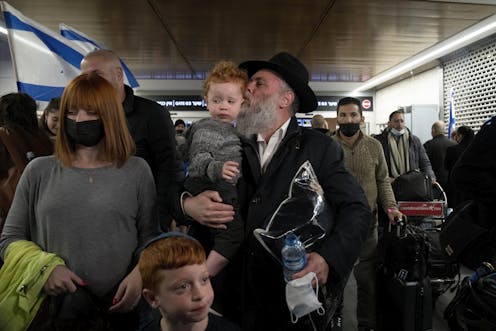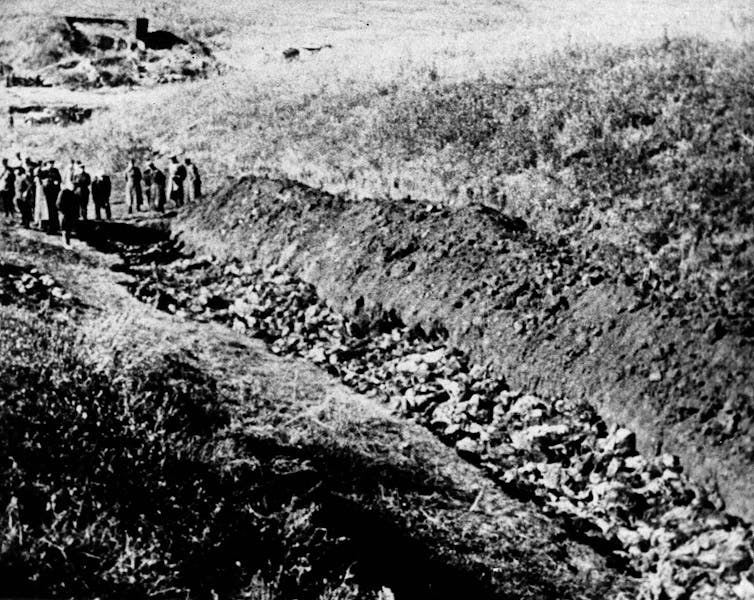
While hundreds of Jews are leaving Kyiv amid Russian attacks, many more, led by the President of Ukraine, Volodymyr Zelensky, who is of Jewish origin, are staying on to defend the country.
Jews have always been part of the long history of Kyiv, which has been ruled for a thousand years by Slavic princes, Normans, Tatars, Lithuanians, Poles, Russians, the Soviet Union, Nazi Germany and Ukrainians. A popular song from 1977 stated that without the Jewish district of Podil, Kyiv would be like St. Vladimir without his cross. Jews comprised 26% of the city’s inhabitants before World War II. Before the current Russian invasion of Ukraine, about 18,000 Jews lived in Kyiv, less than 1% of the total population.
Jews first arrived in Kyiv from the medieval Khazarian State, which was located between the Black Sea and the Caspian Sea, in the 10th century and settled in the Kyivan Rus’ State. While Jews built and developed Kyiv, the city also shaped and developed the identity of Kyivan Jews. Jewish businessmen provided funds for construction of universities, schools, hospitals, markets, research institutes, city public transportation and movie theaters. Kyiv would be quite a different city without Jewish businesses and Jewish humor, Jewish medical doctors and lawyers, who had reputations as among the best in the city.
As a scholar who has written a book on the Jews of Kyiv, I know that there have been many times that Jews were forced to flee from the city – but they always came back.
Kyiv Jewry and its contributions
The rulers of the Polish–Lithuanian State, and of the Russian Empire, expelled Jews from Kyiv repeatedly in the 15th to 19th centuries. The expulsions hurt the city economically, so each time, authorities allowed the Jews back, and they had to restart their Jewish community from scratch.
From 1835 to Russia’s February 1917 Revolution, Kyiv was legally outside of, but surrounded by, the Pale of Jewish Settlement, the 15 western provinces of the Russian Empire where most Jews were allowed to live. Only certain categories of Jews were allowed to live in Kyiv: the wealthiest merchants, Jews with higher education, retired soldiers and several categories of artisans. This situation created the peculiar structure of Kyiv Jewry. At the turn of the 20th century, lawyers, medical doctors, writers and journalists comprised 13% of the Jewish population.
Kyiv came to have one of the wealthiest Jewish communities in the Russian Empire, with considerable influence. The Brodskys and Margolins were prominent Jewish families who made significant contributions to the development of the city and local industry. Kyiv was always attractive for Jews as a large economic and cultural center, despite the open hostility of the authorities and some locals.
This hostility provoked pogroms in Kyiv in 1881 and 1905. During the pogrom of 1905, 100 Jews were killed and several hundred injured. The Russian authorities also organized what came to be known as the “Beilis Affair” when a Jew, Menahem Mendel Beilis, was falsely accused of the ritual murder of a Christian boy in Kyiv.
Opportunities in the Ukrainian People’s Republic
After the collapse of the Russian monarchy, the Ukrainian People’s Republic, which lasted from 1918 to 1920, was established. During these years of Ukrainian independence, important innovations occurred in Jewish cultural life.
On Jan. 9, 1918, the Central Rada, the Ukrainian Parliament, passed a law that guaranteed national and cultural autonomy for minorities. This law opened for Ukrainian Jews many opportunities for cultural development, such as establishment of Jewish organizations and educational institutions that they never had in the Russian Empire.
Unfortunately, the civil war from 1918 to 1920, which was accompanied by anti-Jewish pogroms and widespread anarchy in Ukraine, overwhelmed many of these positive initiatives soon thereafter.
In 1920, the Bolsheviks conquered Ukraine and incorporated it into the newly established Soviet Union in 1922.
Imprisonment under Soviet rule and the Holocaust
Kyiv was one of the two largest centers of Yiddish culture in the Soviet Union – the other was Minsk. Several Jewish state scholarly institutions functioned in Kyiv in the 1920s and 1930s. These included the Jewish Historical-Archaeographical Commission, the Institute of Jewish Proletarian Culture and the Department of Jewish Culture.
Many Yiddish writers and poets lived and worked in Kyiv during the 1920s and 1930s. There were several Yiddish periodicals, three Jewish theaters and many Jewish schools and clubs.
In the mid-1930s, the Soviet policy toward all national minorities, including Jews, suddenly changed. Instead of encouraging the development of the various national cultures of the multinational population of the Soviet Union, the authorities decided to promote the dominant Russian culture and suppress all others.
Most Jewish organizations and institutions were closed in Kyiv and all over the Soviet Union in the second half of the 1930s. Many scholars who worked in these organizations and institutions were imprisoned, and some were executed.

During the Second World War, Kyiv was under Nazi occupation for over two years. Most Kyivan Jews who remained in the city were massacred by the Nazis at the Babi Yar Ravine over two days in September 1941. Depending upon the source, the number of Jews murdered there could be anywhere from 33,771 to 100,000.
Jews who fought on the front or survived by evacuating to the Ural Mountains, Siberia and Central Asia returned to Kyiv after the war.
Due to the policy of state anti-Semitism, all Jewish institutions and organizations were closed in Kyiv and throughout the Soviet Union from the late 1940s until the collapse of communism.
The Soviet authorities, for many years after the war, refused to admit that most of the victims in Babi Yar were Jews and did not build any monument on the site. When the monument was finally built in 1976, it simply said that “Soviet people” were killed there.
Life in independent Ukraine
Jewish life was revived in Kyiv after the collapse of communism and the creation of the independent Ukrainian state in 1991. Several Jewish cultural and community organizations and schools were established in Kyiv, and the synagogues and kosher store were reopened.
In the 1990s, many Jews emigrated from Kyiv and Ukraine to Israel and other countries due to the difficult economic conditions. Today, Jews in Kyiv freely celebrate their religious holidays and participate in Jewish cultural and communal life. They have strong emotional attachments to the city.
The economic, cultural and personal ties that Jews have had for centuries, I believe, will compel many to come back to Kyiv as soon as the political situation permits it. As a fifth-generation Kyivan Jew who emigrated to the U.S., I am well aware of these close connections that have made me return many times to the beautiful city of my birth.
Victoria Khiterer does not work for, consult, own shares in or receive funding from any company or organisation that would benefit from this article, and has disclosed no relevant affiliations beyond their academic appointment.
This article was originally published on The Conversation. Read the original article.







